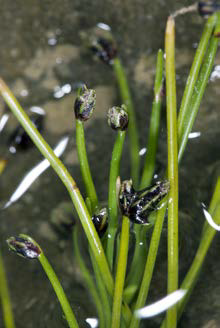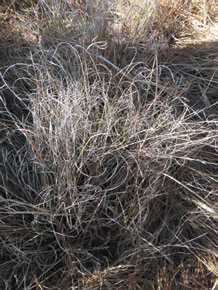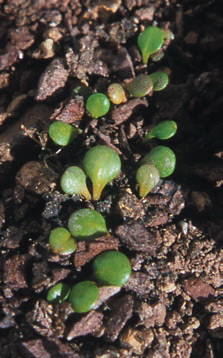Trip Report – 29–31.3.2013: Rangitikei and Foxton areas, Manawatu
Day 1: Ephemeral dune wetlands at Foxton and Himatangi. Round Bush
 |
Isolepis cernua. Photo: Jeremy Rolfe.
|
Most BotSoccers were wise enough to take their packs when Jill Rapson (Massey) suggested a quick look at the dunes and wetlands behind Foxton Surf Club where we met. Half an hour soon became two hours as we started learning the treasures and the weeds. Jill’s explanations increased our awareness of the dynami, but poorly understood, inter-relationships between coastal processes, dune processes, and the impacts of farming and forestry on the water levels in the dune wetlands along the Manawatu coast.
The indigenous plants were special. Standing up, we could see
Coprosma acerosa, the hairy
Pimelea arenaria (even the petals are hairy), and even the Manawatu endemic
Selliera rotundifolia. We had to kneel, with eyes close to the ground, to see
Lilaeopsis novae-zelandiae,
Ranunculus acaulis and
Triglochin striatum. Dry wetlands have their advantages.
We lunched before entering the Omarupapako (Round Bush) Scenic Reserve, a 50-ha remnant of coastal swamp forest 4 km north of Foxton Beach. It is a kahikatea / pukatea forest, with flax, raupo and cabbage trees in more open areas. The reserve is one of three coastal reserves in the area that will be managed under DOC’s Natural Heritage Management System (NHMS). A web site seeks volunteers for a roster to check mustelid traps in these reserves.
Excellent ice-creams in Himatangi, and a short trip along the wide sandy beach, took us close to our final site for the day, a dry ephemeral wetland on private land. Viv McGlynn (Manawatu) promised spiders, and she produced a baby katipo when she picked up her fourth piece of drift wood. Jill promised and delivered more botanical treasures, all tiny, including
Eleocharis neozelandica,
Gunnera dentata,
Isolepis cernua, the tiny
Isolepis basilaris and
Myriophyllum votschii.
Foxton Beach Motor Camp’s comfortable tent sites provided relief for tired muscles after so many ups and downs during the day.
Day 2 (morning): Koitiata Reserve, Turakina
Firstly, context. I am a tramper who knows little about plants. This was my inaugural trip with BotSoc, and I must say, it’s all about expectations. I got very excited looking at the trip schedule, because we were meeting at the Turakina Pub. I thought it a little ‘hard-core’ that the pub-crawl was before we’d done anything, but who am I to change what works...
Sadly, the pub was shut (Easter), and with expectations dashed, I’m sure that someone else has written about the fourteen people gathered on a traffic island, before heading down a side road. Next stop, the most dangerous corner you can find, six cars parked on the side of the road, to look at an exciting giant sedge. As interesting as Colin Ogle’s commentary was, I was a tad distracted by the 1500 kg bull standing 20 feet behind him. BotSoccers are fearless!
We botanised near the mouth of the Turakina River (Koitiata Recreation Reserve), and then headed for Waimahora within the pine forest. The gate was locked, so we went to the lake. Apparently, permission had been obtained from local iwi, but not from surrounding land owners. So we kept an eye-out for unhappy locals, and within minutes had upset some cows which ran to the other end of the field. I felt rather relieved there were no bulls, giant or otherwise. Strawberry clover was pointed out to me, growing in the paddock. A cruel name, made to make my mouth water.
Safely on the other side of the fence, an intense discussion ensued about whether the carpet of plants on the lakefront was a hydrocotyle or a schizeilema. Certainly, there was raupo which even I could identify, a few bachelor’s buttons, forget-me-nots, lotus, veronica, myriophyllum, lilaeopsis, juncus, persicaria ... the list goes on. I got rather confused, remembering a limacella as a green musical instrument, but there were plenty of people to put me right.
I’d like to say a huge thank you for being invited on such a wonderful trip. BotSoc hospitality is hard to beat, and I’ll be back again as soon as I am able.
Nga mihi kia koutou.
Margaret Craigie
Day 2
As we approached Santoft Forest with the intention of botanising the infrequently visited Waimahora wetland within, we soon realised that access was denied, via the locked gate; much to Mick’s disbelief, and our amusement. So our magical mystery-tour leader conjured up the backup plan. Lake Kotiati became our shining jewel, with a lake-edge lined with raupo, willows, poplars, cabbage tree,
Coprosma propinqua agg., one mamaku, much bracken, some smaller botanical treasures among the wetland plants, many exotics, and extensive pasture grasses. Across these grass paddocks, Jill Rapson herded us as the many cows heard us and “moo-ved’ along as we approached. Soon we were getting amongst the dirt, admiring
Potentilla anserinoides,
Limosella sp. in flower, and yes, we found the newly learnt
Isolepis basilaris here also, beneath some beggars’ ticks, willow weeds, forget-me-nots and many others. Soon Leon and Lara were getting their feet very wet, identifying the endemic
Hydrocotyle sulcata, and the exotic water fern,
Azolla pinnata, a new record of invasion for this fern. All in all, it turned out to be a gem of a location, with many small botanical treasures, and lots of unlocked educational potential from our more experienced botanisers handing over their valuable information to the rest of us. I would like to give my thanks to everyone who delighted us on this leg of the trip. I have a magical mystery- bag of specimens that came home with me which I am still enjoying trying to identify.
Jenny Dolton
Day 3: Tangimoana foreshore & Tawhirihoe Scientific Reserve Pasture pines & pampas
 |
| Carex litorosa. Photo: Julia Stace. |
We, the remaining twelve, were guided by Hilary Robson, a local involved in coastal restoration at Tangimoana, and two others also with knowledge of Manawatu plants, Vivienne McGlynn and Jill Rapson. They told us about the impact of the shifting course of the rivers, farming and forestry, on the wetland swales and their vegetation, and about the work done by botany students in recent years.
Near the boat ramp on the south bank of the Rangitikei River we saw the rare
Carex litorosa, a small, nondescript carex disappearing unnoticed from the coast around NZ. Hilary has been growing and planting it out for some time.
Falling into the high tide along the estuary’s exposed edges are scattered plants of shore cotula,
Leptinella dioica.
Despite attempts at eradication, the huge grass,
Phragmites australis, was re-growing at the boat ramp – it is a serious weed problem throughout the estuary. Volunteers were trying hard to control it, but sprays that affect aquatic life cannot be used, so this job is very difficult.
Tawhirihoe Scientific Reserve was set up to protect one of the best remaining wetlands in the Manawatu. It is now an area of wetlands in decline. Oioi, other rushes,
Austroderia toetoe and cabbage trees are part of the natural progression filling in the wetlands, plus weeds, e.g. pampas and tree lupin. No new wetlands have developed naturally since the land was reserved.
An artificial wetland, dug out and fenced off, has not been as well colonised as hoped, by the tiny wetland plants hanging on nearby. The water in it is still knee-deep, rising from a water table polluted by the expansion of dairying on the Manawatu plains. So the water quality is very poor, with slimes on the bottom of the pond. Previously this wetlands area had clear, clean water when flooded.
 |
| Selliera rotundifolia. Photo: Barbara Mitcalfe. |
As these little wetland plants are naturally submerged in the wetter months, this may be a factor in the lack of colonisation. However the delightful
Selliera rotundifolia had established there.
We saw a single plant, with a seedling close by, of
Pimelea actea. It is rated Nationally Critical and Jill Rapson estimates there may be as few as 40 plants left on the planet, all of them are here probably. Despite efforts to raise, cultivate and plant it out, it continues to disappear. The more common
P. villosa is scattered through the reserve.
Tawhirihoe Scientific Reserve is criss-crossed with trails destabilising the dunes. We saw numerous quad bikes and motor bikes, despite the signage, ‘If you drive on it you will destroy it’.
Interestingly, the local garden waste and weed dump is alongside the scientific reserve. We saw similar dumping at Koitiata settlement where several of us harvested mature pumpkins.
To sum up this weekend, we drove long distances from our base at Foxton Motor Camp to look for remnant populations of tiny wetland plants. This tragedy is compounded by the knowledge that this area was once primeval wetland forest on river plains. Broadly all that remains to be seen today are mature pines on old sand dunes, pasture and pampas.
Julia Stace, jbwstace (at) gmail.com, www.jbwphotography.co.nz.
Further insights to the trip can be accessed via the Te Papa website where two of the trip members have regular blogs.
Leon’s Te Papa blog:
http://blog.tepapa.govt.nz/2013/04/02/the-small-and-the-weedy-foxton-field-trip/
Lara’s Te Papa blog:
http://blog.tepapa.govt.nz/2013/04/11/a-few-more-botanical-highlights-from-the-foxton-fieldtrip-and-a-katipo-spider/.
Participants : Bev Abbott, Barbara Clark, Rae Collins, Margaret Craigie, Jenny Dolton, Chris Hopkins, Rodney Lewington, Vivienne McGlynn (Manawatu), Colin Ogle (Whanganui), Mick Parsons, Leon Perrie, Jill Rapson (Manawatu), Hillary Robson (Manawatu), Lara Shepherd, Barbara Simmons, Julia Stace.
We owe special thanks to Jill Rapson and other Manawatu members for guiding us and allowing us to appreciate how special and unique are these neglected coastal sites of the Manawatu.

 Site Index
Site Index







 Site Index
Site Index





